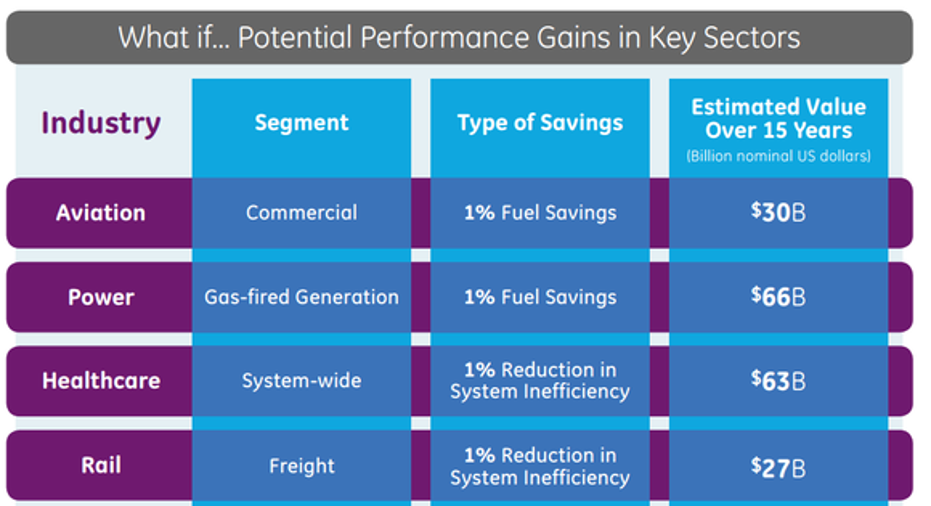What Is the Industrial Internet?

Image source: General Electric.
General Electric's (NYSE: GE) management throws around the term "Industrial Internet" quite often these days. In many ways, the Industrial Internet embodies GE's vision for the future and the growth opportunity surrounding it. After all, GE is in the process of exiting the traditional financial services business by divesting more than $200 billion in assets tied to GE Capital. What's left is a company primarily focused on industrial activities. By 2018, GE is targeting to generate at least 90% of its operating income from industrial activities, up from 58% in 2014.
To drive industrial growth, GE has turned to long-term opportunities like the Industrial Internet.
What is the Industrial Internet?
Essentially, the Industrial Internet can be thought of as the Internet of Things for industry, and is sometimes referred to as the Industrial Internet of Things (IIoT). The Industrial Internet sits at the intersection of industrial assets, internet-connected sensors, big-data analytics, and real-time optimization. An industrial asset could be a single industrial machine like a jet engine, a fleet of industrial machines that operate in a factory, or an entire industrial site like a wind farm, factory, or power plant. Overall, the purpose of the Industrial Internet is to improve the productivity, efficiency, and reliability of industrial assets for operators.
As an Industrial Internet pioneer, GE is building out an expansive suite of digital services to help industrial customers leverage the power the Industrial Internet. By subscribing to GE's digital offerings, Emirates, a major GE Aviation customer, reduced disruptions and planned maintenance by 43% annually during the first half of 2016, and added 12 days of utilization across its fleet ofBoeing777s in the same period.
How big is the Industrial Internet?
While a 1% improvement in productivity may not sound like much, it can translate to massive savings for large industrial operators and entire industries. General Electric estimates that a 1% improvement in productivity across its manufacturing base equates to $500 million in savings per year. Worldwide, GE believes, a 1% improvement in industrial productivity could add$10 trillion to $15 trillionto global GDP over the next 15 years.
The following graphic illustrates what a 1% productivity gain could look like across select industry segments over a 15-year period:
Image source: General Electric.
Given the potential for strong returns on investment, GE is approaching the Industrial Internet as a user and as a business. Essentially, GE's industrial operations have become a proving ground to develop productivity-enhancing Industrial Internet services for itself and the marketplace.
For instance, GE's Brilliant Factory initiative, which aims to improve a factory's operations in real time using automation and big data, became a commercialized service after it delivered performance improvements internally. In one example, after GE's Greenville, South Carolina, factory became "Brilliant," productivity improved by 25% over a three-month period.
The Industrial Internet's largest players
While GE is considered the leader in Industrial Internet services, it is not alone in the market. Most notably, Honeywell (NYSE: HON) and Siemens (NASDAQOTH: SIEGY) have made inroads in developing software that can tap into the Industrial Internet, but remain smaller players than GE.
Last year, GE generated $5 billion in software sales, while Siemens' digital services generated about $678 million in revenue, and Honeywell's digital revenue was too small to disclose. By 2020, GE hopes to generate over $15 billion per year in software sales. And in the coming years, Siemens and Honeywell are expected to continue investing in the Industrial Internet and making their presence more known.
The bigger picture
For users, the Industrial Internet offers the promise of improved productivity for a clearly defined cost. As long as the potential cost savings exceed the costs of implementing the Industrial Internet, it's an easy sell for Industrial Internet service providers.
However, the Industrial Internet is a relatively new industry, and overall awareness -- a prerequisite of adoption -- remains low. In other words, there may be a considerable time gap before adoption rates reach critical mass. Until then, investors should expect GE and other companies to continue sharing their early successes as a way to validate to the marketplace that the Industrial Internet is worth a deeper look.
A secret billion-dollar stock opportunity The world's biggest tech company forgot to show you something, but a few Wall Street analysts and the Fool didn't miss a beat: There's a small company that's powering their brand-new gadgets and the coming revolution in technology. And we think its stock price has nearly unlimited room to run for early in-the-know investors! To be one of them, just click here.
Steve Heller has no position in any stocks mentioned. The Motley Fool owns shares of General Electric. Try any of our Foolish newsletter services free for 30 days. We Fools may not all hold the same opinions, but we all believe that considering a diverse range of insights makes us better investors. The Motley Fool has a disclosure policy.



















